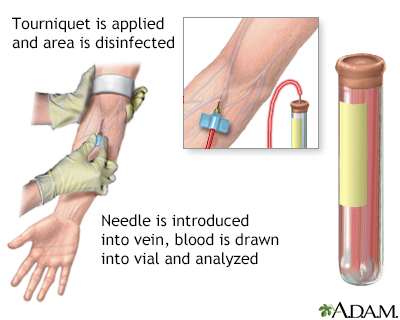Comprehensive metabolic panel
A comprehensive metabolic panel is a group of blood tests. They provide an overall picture of your body's chemical balance and metabolism. Metabolism refers to all the physical and chemical processes in the body that use energy.
How the Test is Performed
A blood sample is needed.
Blood sample
Venipuncture is the collection of blood from a vein. It is most often done for laboratory testing.

How to Prepare for the Test
You should not eat or drink for at least 8 hours before the test.
How the Test will Feel
When the needle is inserted to draw blood, some people feel moderate pain. Others feel only a prick or stinging. Afterward, there may be some throbbing or a slight bruise. This soon goes away.
Why the Test is Performed
This test gives your health care provider information about:
- How your kidneys and liver are working
- Blood sugar and calcium levels
- Sodium, potassium, and chloride levels (called electrolytes)
- Protein levels
Your provider may order this test to check you for side effects of medicines or for diabetes, liver disease, or kidney disease.
Normal Results
Normal values for the panel tests are:
- Albumin: 3.4 to 5.4 g/dL (34 to 54 g/L)
- Alkaline phosphatase: 20 to 130 U/L (0.33 to 2.17 µkat/L)
- ALT (alanine aminotransferase): 4 to 36 U/L (0.07 to 0.60 µkat/L)
ALT
The alanine transaminase (ALT) blood test measures the level of the enzyme ALT in the blood.
 ImageRead Article Now Book Mark Article
ImageRead Article Now Book Mark Article - AST (aspartate aminotransferase): 8 to 33 U/L (0.13 to 0.55 µkat/L)
AST
The aspartate aminotransferase (AST) blood test measures the level of the enzyme AST in the blood.
 ImageRead Article Now Book Mark Article
ImageRead Article Now Book Mark Article - BUN (blood urea nitrogen): 6 to 20 mg/dL (2.14 to 7.14 mmol/L)
BUN
BUN stands for blood urea nitrogen. Urea nitrogen is what forms when protein breaks down. A test can be done to measure the amount of urea nitrogen ...
 ImageRead Article Now Book Mark Article
ImageRead Article Now Book Mark Article - Calcium: 8.5 to 10.2 mg/dL (2.13 to 2.55 mmol/L)
- Chloride: 96 to 106 mEq/L (96 to 106 mmol/L)
Chloride
Chloride is a type of electrolyte. It works with other electrolytes such as potassium, sodium, and carbon dioxide (CO2). These substances help keep...
 ImageRead Article Now Book Mark Article
ImageRead Article Now Book Mark Article - CO2 (carbon dioxide): 23 to 29 mEq/L (23 to 29 mmol/L)
CO2
CO2 is carbon dioxide. This article discusses the laboratory test to measure the amount of carbon dioxide in the liquid part of your blood, called t...
 ImageRead Article Now Book Mark Article
ImageRead Article Now Book Mark Article - Creatinine: 0.6 to 1.3 mg/dL (53 to 114.9 µmol/L)
Creatinine
The creatinine blood test measures the level of creatinine in the blood. This test is done to see how well your kidneys are working. Creatinine in t...
 ImageRead Article Now Book Mark Article
ImageRead Article Now Book Mark Article - Glucose: 70 to 100 mg/dL (3.9 to 5.6 mmol/L)
- Potassium: 3.7 to 5.2 mEq/L (3.70 to 5.20 mmol/L)
Potassium
This test measures the amount of potassium in the fluid portion (serum) of the blood. Potassium (K+) helps nerves and muscles communicate. It also ...
 ImageRead Article Now Book Mark Article
ImageRead Article Now Book Mark Article - Sodium: 135 to 145 mEq/L (135 to 145 mmol/L)
Sodium
The sodium blood test measures the concentration of sodium in the blood. Sodium can also be measured using a urine test.
 ImageRead Article Now Book Mark Article
ImageRead Article Now Book Mark Article - Total bilirubin: 0.1 to 1.2 mg/dL (2 to 21 µmol/L)
- Total protein: 6.0 to 8.3 g/dL (60 to 83 g/L)
Normal values for creatinine can vary with age.
Normal value ranges for all tests may vary slightly among different labs. Some labs use different measurements or may test different specimens. Talk to your provider about the meaning of your specific test results.
What Abnormal Results Mean
Abnormal results can be due to a variety of different medical conditions. These may include kidney disease, liver disease, breathing problems, and diabetes or diabetes complications.
Risks
There is little risk involved with having your blood taken. Veins and arteries vary in size from one person to another and from one side of the body to the other. Taking blood from some people may be more difficult than from others.
Other risks associated with having blood drawn are slight but may include:
- Excessive bleeding
- Fainting or feeling lightheaded
- Multiple punctures to locate veins
- Hematoma (blood accumulating under the skin)
- Infection (a slight risk any time the skin is broken)
Reviewed By
Frank D. Brodkey, MD, FCCM, Associate Professor, Section of Pulmonary and Critical Care Medicine, University of Wisconsin School of Medicine and Public Health, Madison, WI. Also reviewed by David C. Dugdale, MD, Medical Director, Brenda Conaway, Editorial Director, and the A.D.A.M. Editorial team.
McPherson RA, Pincus MR. Disease/organ panels. In: McPherson RA, Pincus MR, eds. Henry's Clinical Diagnosis and Management by Laboratory Methods. 24th ed. Philadelphia, PA: Elsevier; 2022:chap 7.




